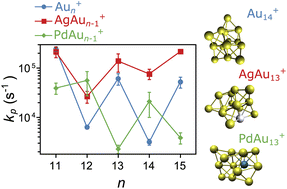Radiative cooling in silver and palladium doped gold clusters
Abstract
The emission of photons from a thermally populated electronic excited state, via the process of recurrent fluorescence, has been recognized as a prominent cooling channel in hot molecules and small metal clusters. For the latter case, however, only monometallic species have been investigated to date. An active radiative cooling channel has a stabilizing effect and can favor the size and composition specific production of selected clusters. In this work, the influence of silver and palladium doping on the radiative cooling of gold cluster cations is studied. The quenching of metastable fragmentation due to radiation of laser-excited Aun+, AgAun−1+ and PdAun−1+ (n = 11–15) clusters is investigated in a single-pass molecular beam setup. The observed high radiation rates, with values in the range from 103 to 105 s−1, are consistent with recurrent fluorescence. The rates present a pronounced odd–even staggering with higher values for the clusters with closed-shell electronic configurations. While substitution of Au with Ag does not alter the odd–even pattern with cluster size, replacing Au with Pd shifts the pattern by one atom. The experimental observations are discussed in terms of the dissociation energy of the clusters, which sets their effective temperature during photon emission, and the low-lying electronic excited states involved in the photon emission process. Linear-response time-dependent density functional theory calculations on selected species are used to illustrate the significant effect of the electronic structure on the radiation rates. For n = 14, substitution of Au with Ag lowers the energy of the lowest-energy transition in the cluster, which in addition has a higher oscillator strength, favoring radiative cooling. The opposite effect is seen in Pd doped clusters. Based on this analysis, conclusions can be drawn about the significance of radiative cooling in laser-excited alloy clusters, with a concomitant fast stabilization at high internal energy conditions.

- This article is part of the themed collection: Nanoalloys: recent developments and future perspectives


 Please wait while we load your content...
Please wait while we load your content...